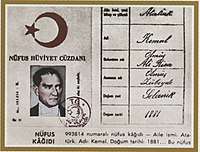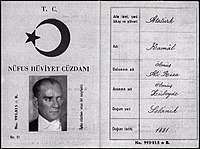Surname Law (Turkey)
The Surname Law (Turkish: Soyadı Kanunu) of the Republic of Turkey was adopted on 21 June 1934.[1] The law requires all citizens of Turkey to adopt the use of fixed, hereditary surnames. Much of the population, particularly in the cities as well as Turkey's Christian and Jewish citizens, already had surnames, and all families had names by which they were known locally. The Surname Law of 1934 enforced not only the use of official surnames but also stipulated that citizens choose Turkish names. Until it was repealed in 2013, the eldest male was the head of household and Turkish law appointed him to choose the surname. However in his absence, death, or mental incapacitation the wife would do so.[2]
Origin
The Turkish MP Refik Şefik İnce has suggested that instead of using the term Soyadı (Kanunu), it should be used the term Sanadı (Kanunu) (known name) as used in Ottoman times. But the Grand National Assembly of Turkey decided to use the term Soyadı because it denoted the meaning of race, breed, family, or relative.[3]
This law was modeled after a 1926 Fascist Italianization law "restoring" German, Slovene and Croat surnames to their 'original Italian form'.[4][5]
Muslims in the Ottoman Empire carried titles such as "Pasha", "Hoca", "Bey", "Hanım", "Efendi". These titles either defined their formal profession (such as Pasha, Hoca, etc.) or their informal status within the society (such as Bey, Hanım, Efendi, etc.). Ottoman prime ministers (Sadrazam/Vezir-î Azam or Grand Vizier), ministers (Nazır/Vezir or Vizier) and other high-ranking civil servants also carried the title Pasha. Retired generals/admirals or high-ranking civil servants continued to carry this title in civilian life. A "Pasha" did not become a "Bey" after retiring from active military or political service.
The Surname Law
The articles of the Soy Adı Kanunu[6] stipulated that:
- All Turks must bear their surnames in addition to their proper name;
- The surname must follow the proper name in signing, speaking and writing;
- Names may not relate to military rank and civil officialdom; to tribes, foreign races or ethnicities; nor may they be offensive or ridiculous. The use of "historical names" without the proper genealogical evidence is also forbidden.
The surname law specifically forbade certain surnames that contained connotations of foreign cultures, nations, tribes, and religions.[7][8][9][10] New surnames had to be taken from the Turkish language. The surname could be used with the ‑oğlu ending, and it was forbidden to use Armenian endings such as ‑ian or ‑yan, Slavic endings such as ‑of (or ‑ov), ‑vich, ‑ic, Greek endings such as ‑is, ‑dis, ‑pulos, ‑aki, Persian endings such as ‑zade, and Arab endings such as ‑mahdumu, ‑veled, and ‑bin, "referring to other ethnicities or taken from another language." For example, names such as Arnavutoğlu (the Albanian’s son) or Kürtoğlu (the Kurd's son), could not be used. Names of clans or tribes could not be used, or re-used.[11] Additionally, names could not be duplicated in the same district, and, in case of any dispute, the family that registered first got the right to keep the claimed name.[12]
Implementation
As a result, many Greeks, Bulgarians, Albanians, Bosniaks, Jews, Arabs, Armenians, Assyrians, Georgians and Kurds were forced to adopt last names of a more Turkish rendition,[7] sometimes directly translating their original surnames, or otherwise just replacing markers such as Pontic Greek "‑ides" (son of) with Turkish “‑oğlu” (Kazantzoglou, Mitroglou, Mouratoglou, etc.).
References
- 1934 in history, Turkish Ministry of Culture and Tourism.
- Turkoz, Meltem (2004). "The Social Life of the State's Fantasy: Memories and Documents on Turkey's Surname Law of 1934". ScholarlyCommons. University of Pennsylvania. Retrieved 2020-05-28.
- Bayir, Derya (2016-04-22). Minorities and Nationalism in Turkish Law. Routledge. p. 104. ISBN 978-1-317-09580-4.
- Regio decreto legge 10 Gennaio 1926, n. 17: Restituzione in forma italiana dei cognomi delle famiglie della provincia di Trento
- Mezulić, Hrvoje; R. Jelić (2005) Fascism, baptiser and scorcher (O Talijanskoj upravi u Istri i Dalmaciji 1918-1943.: nasilno potalijančivanje prezimena, imena i mjesta), Dom i svijet, Zagreb, ISBN 953-238-012-4
- "Soy Adı Kanunu" (PDF). Archived from the original (PDF) on 2017-01-07.
- İnce, Başak (2012-04-26). Citizenship and identity in Turkey : from Atatürk's republic to the present day. London: I.B. Tauris. ISBN 9781780760261.
- Aslan, Senem. "Incoherent State: The Controversy over Kurdish Naming in Turkey". European Journal of Turkish Studies. Retrieved 16 January 2013.
the Surname Law was meant to foster a sense of Turkishness within society and prohibited surnames that were related to foreign ethnicities and nations
- Suny, Ronald Grigor; Goçek, Fatma Müge; Naimark, Norman M., eds. (2011-02-23). A question of genocide : Armenians, and Turks at the end of the Ottoman Empire. Oxford: Oxford University Press. ISBN 9780195393743.
- Toktas, Sule (2005). "Citizenship and Minorities: A Historical Overview of Turkey's Jewish Minority". Journal of Historical Sociology. 18 (4): 394–429. doi:10.1111/j.1467-6443.2005.00262.x. Retrieved 7 January 2013.
- "Soy Adı Nizamnamesi" (PDF). Archived from the original (PDF) on 2015-11-23.
- Turkoz, Meltem (2007). "Surname narratives and the state–society boundary: Memories of Turkey's family name law of 1934". Middle Eastern Studies. 43 (6): 893–908. doi:10.1080/00263200701568253.
External links


